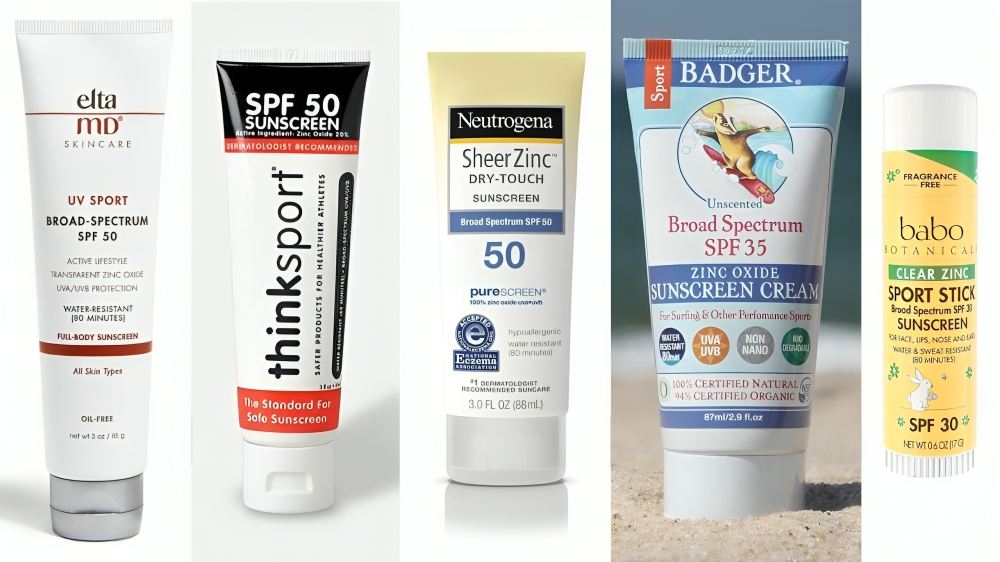As a cricketer, you often spend long hours under the sun. During training or matches, these hours quickly add up, and as you push yourself, sweating becomes inevitable-that’s where the challenge begins.
Did you know perspiration is the downfall of many leading sunscreens?
Fortunately, finding the ideal sunscreen for cricket doesn’t have to be difficult. After researching the best ways to protect cricketers from UV rays, Simply Sun Safe recommends Elta MD UV Sport Sunscreen Lotion, Broad-Spectrum SPF 50 as the top choice.
Best Sunscreen for Cricketers Comparison

| Best Sunscreen for Cricketers Comparison | EltaMD UV Sport Sunscreen | Thinksport SPF 50+ Mineral Sunscreen | Badger SPF 35 Sport Sunscreen Cream | Neutrogena Sheer Zinc Dry-Touch Sunscreen | Babo Botanicals Clear Zinc Sport Stick |
|---|---|---|---|---|---|
| SPF | 50 | 50+ | 35 | 50 | 30 |
| Broad Spectrum | Yes | Yes | Yes | Yes | Yes |
| Active Ingredients | Zinc Oxide (9%), Octinoxate (7.5%), Octisalate (5%) | Zinc Oxide (20%) | Zinc Oxide (22.5%) | Zinc Oxide (18.24%) | Zinc Oxide (20%) |
| Water Resistance | 80 minutes | 80 minutes | 80 minutes | 80 minutes | 80 minutes |
Buyer’s Guide
Choosing the right product can be tough, especially with something like sunscreen. This guide covers the essentials to look for when buying sunscreen as a cricketer.
Key Features for Cricketers
Broad Spectrum Protection
As a cricketer spending long hours in the sun, broad spectrum protection is essential. This means it shields against both UVA and UVB rays, which affect the skin differently.
- UVB Rays: These cause burning and tanning by damaging the skin’s outer layer. Prolonged exposure, such as during a cricket match, can lead to painful burns by the end of a session.
- UVA Rays: These are more insidious, penetrating deep into the skin (the dermis) and causing premature aging. Without protection, these rays can leave you with lasting damage.
Both UVA and UVB exposure also increase the risk of skin cancer—something cricketers are particularly prone to due to extended sun exposure.
Best SPF for Cricketers
Cricketers should understand that SPF shows how much of the sun’s rays reach the skin. For example, SPF 30 allows only 1/30th of rays to pass through, while SPF 50 allows only 1/50th. Though high SPF ratings provide slightly more protection, Simply Sun Safe aligns with the British Association of Dermatologists’ guidelines, recommending SPF 30–50+ for outdoor sports like cricket. Remember, regardless of SPF rating, reapply every two hours for effective sun protection!
| SPF Rating | UVB Protection |
| None | 0% |
| 2 | 50% |
| 15 | 93% |
| 30 | 97% |
| 50 | 98% |
| 100 | 99% |
Physical is better than chemical
Physical sunscreens are often preferred over chemical ones. Did you know sunscreens fall into two categories—chemical and physical? They differ in both their active ingredients and how they shield your skin from UV rays. Chemical sunscreens work by absorbing UV rays once they hit your skin, whereas physical sunscreens reflect UV rays, blocking them before they reach the skin.
Does one option feel safer than the other?
There are several reasons to prefer physical sunscreens over chemical ones. Physical sunscreens:
- Work immediately upon application (no waiting time before play!)
- Last longer
- Cause less irritation
- Have a longer shelf life
Still not convinced? Consider this: many chemical sunscreens contain ingredients that can disrupt hormones, which is not ideal for athletes. The most concerning of these chemicals is oxybenzone, which you should avoid at all costs!
Physical sunscreen offers the best protection while you’re playing cricket in the sun!
Water Resistance
Water resistance is crucial for cricketers! Spending hours under the hot sun means you will sweat, and physical exertion only adds to that. Therefore, you need a sunscreen that won’t wash away at the first drop of sweat. Look for sunscreens with either 40 or 80 minutes of water resistance. I recommend opting for those with 80 minutes, providing longer-lasting protection and peace of mind during training and games.
Zinc Oxide as an Active Ingredient
Now that you understand the benefits of physical sunscreens, let’s talk about a key ingredient: zinc oxide. It’s the strongest sunscreen ingredient, protecting against the full spectrum of UVA/B rays. Choose sunscreens with higher concentrations of zinc oxide for the best protection. Just be prepared for a white cast on your face—think of it as proof of effective protection and a nod to the legends of the game!
Higher SPF for Lighter Skin
As a rule of thumb, never choose a sunscreen with an SPF lower than 30. If you have fair skin, consider using sunscreens with SPF ratings closer to 50. SPF protects against burning and tanning, so if your skin is sensitive and prone to burns, investing in a higher SPF is worthwhile!

